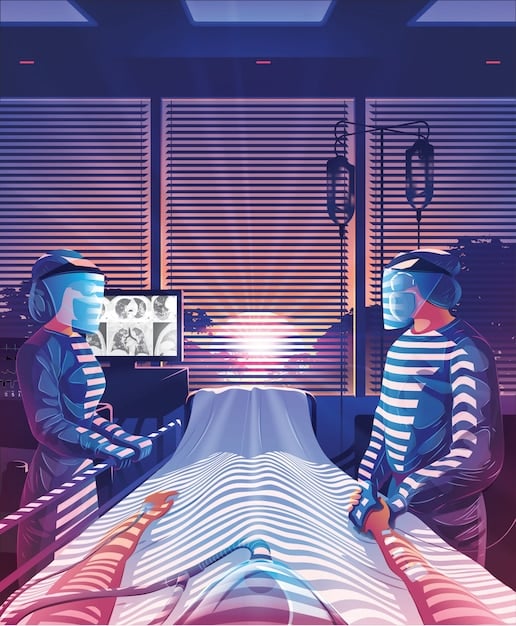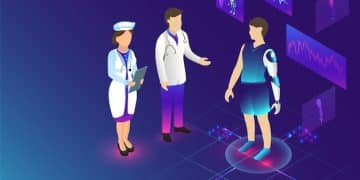AI in US Healthcare: Automating Solutions for Nursing Shortage

AI in US Healthcare: Addressing the Nursing Shortage with Automation involves leveraging artificial intelligence to streamline tasks, improve efficiency, and alleviate the strain caused by the growing shortage of nurses in the United States healthcare system.
The healthcare industry in the United States faces a significant challenge: a severe nursing shortage. This shortage affects patient care, increases workload for existing staff, and strains the overall healthcare system. However, AI in US Healthcare: Addressing the Nursing Shortage with Automation is emerging as a promising solution, offering innovative ways to support nurses, improve efficiency, and ultimately enhance patient outcomes.
Understanding the US Nursing Shortage
The nursing shortage in the US is not a new phenomenon, but it has been exacerbated by factors such as an aging population, increased demand for healthcare services, and the burnout experienced by many healthcare professionals. This section explores the root causes and impact of this critical issue.
Factors Contributing to the Shortage
Several converging factors have created the perfect storm for the nursing shortage. These include:
- Aging Workforce: A significant portion of the nursing workforce is nearing retirement age, leading to a decrease in experienced nurses.
- Increased Demand: The aging population requires more healthcare services, increasing the demand for nurses.
- Burnout: High stress levels, long hours, and emotional toll contribute to nurse burnout, causing many to leave the profession.
- Limited Capacity in Nursing Programs: Nursing schools often have limited capacity, restricting the number of new nurses entering the workforce.
These factors, combined with geographic disparities in healthcare access, further intensify the shortage in certain regions.
Impact on Patient Care
The nursing shortage directly impacts patient care in several ways:
- Reduced Attention: With fewer nurses, each patient receives less individual attention, potentially leading to increased risk of complications.
- Increased Wait Times: Short staffing can lead to longer wait times for treatments and medications.
- Higher Risk of Errors: Overworked nurses are more prone to making errors, increasing the risk of medical mistakes.
- Decreased Job Satisfaction: The increased workload and stress levels can lead to decreased job satisfaction among nurses, further exacerbating the shortage.

This perfect storm of factors warrants innovative strategies to improve efficiency and alleviate some of the pressures facing the system. AI has emerged as a key tool to address these challenges by providing workflow efficiencies and improving overall productivity for nurses.
The Role of AI in Alleviating the Nursing Shortage
Artificial intelligence offers a range of solutions to address the nursing shortage by automating tasks, improving efficiency, and providing decision support. This section explores the areas where AI can have the most significant impact.
Automation of Routine Tasks
One of the most promising applications of AI is the automation of repetitive and time-consuming tasks. This can free up nurses to focus on more complex and critical aspects of patient care.
- Medication Management: AI-powered systems can automate medication dispensing, tracking, and reconciliation, reducing the risk of errors and saving time.
- Patient Monitoring: AI-enabled devices can continuously monitor patient vital signs, alerting nurses to potential issues in real-time.
- Administrative Tasks: AI can automate scheduling, documentation, and billing processes, reducing the administrative burden on nurses.
- Inventory Management: AI systems can track and manage hospital supplies, ensuring that nurses always have the necessary resources available.
By automating these routine tasks, AI can significantly reduce the workload on nurses, allowing them to focus on patient interaction, critical decision-making, and specialized care.
AI-Powered Decision Support
AI can also provide valuable decision support to nurses, helping them make more informed and effective treatment decisions.
AI algorithms can analyze vast amounts of patient data, including medical history, lab results, and imaging scans, to identify patterns and predict potential risks. This information can help nurses:
- Identify high-risk patients: AI can identify patients who are at risk of developing complications, allowing nurses to intervene early and prevent adverse events.
- Personalize treatment plans: AI can help tailor treatment plans to individual patient needs, improving the effectiveness of care.
- Improve diagnostic accuracy: AI can assist in interpreting medical images and lab results, leading to more accurate diagnoses.
AI-powered decision support can also help nurses stay up-to-date with the latest medical research and best practices, ensuring that they are providing the highest quality care possible.
These AI-driven tools support nurses in providing patients with improved and accurate care, while also increasing job satisfaction for the nurses themselves.
Specific AI Applications in Healthcare
AI has a diverse impact on the efficiency of the nursing staff. From AI powered charting systems to robot assistants, the applications are numerous and continue to grow.
AI-Assisted Charting Systems
Many AI charting systems assist nurses in rapidly adding patient information into digital systems.
AI-assisted charting systems can automatically transcribe voice notes, extract relevant information from documents, and populate fields in electronic health records (EHRs). This can save nurses significant time and reduce the risk of errors associated with manual data entry.
The AI can record and remember a patient’s vitals over a given time period to identify and alert staff of anomalies that need immediate attention.
Robotic Assistance in Patient Care
Robotic systems and aids can play a key role in allowing nurses to prioritize their time on other areas of healthcare.
Robots can assist with tasks such as:
- Delivering medications and supplies: Robots can transport medications, supplies, and lab samples throughout the hospital, freeing up nurses to focus on patient care.
- Assisting with patient mobility: Robots can help patients move from their beds to chairs or wheelchairs, reducing the risk of falls and injuries.
- Providing companionship: Social robots can provide companionship and emotional support to patients, particularly those who are isolated or lonely.
While robots are not intended to replace nurses, they can augment their capabilities and improve the overall patient experience.
Predictive Analytics for Staffing
AI can be used to predict patient census and staffing needs, allowing hospitals to optimize nurse staffing levels and prevent shortages.
By analyzing historical data, AI algorithms can forecast patient admissions, discharges, and acuity levels. This information can help hospitals:
- Anticipate staffing needs: Hospitals can use AI to predict when they will need more nurses and proactively adjust staffing levels.
- Optimize nurse assignments: AI can help match nurses with patients based on their skills and experience, ensuring that patients receive the best possible care.
- Reduce overtime costs: By optimizing staffing levels, hospitals can reduce the need for overtime and save money.

Combining these diverse applications of AI, the industry will see an overall better experience for the nurses, patients and healthcare systems alike.
Overcoming Challenges and Ensuring Ethical Implementation
While the potential benefits of AI in healthcare are significant, there are also challenges and ethical considerations that must be addressed. This section explores these issues and discusses strategies for responsible implementation.
Data Privacy and Security
AI systems rely on vast amounts of patient data, raising concerns about data privacy and security. It is crucial to implement robust security measures to protect patient data from unauthorized access and misuse.
These measures should include:
- Data encryption: Encrypting patient data both in transit and at rest.
- Access controls: Limiting access to patient data to authorized personnel only.
- Regular audits: Conducting regular audits to ensure compliance with privacy regulations.
- Patient consent: Obtaining informed consent from patients before using their data for AI applications.
Addressing these concerns is essential for maintaining patient trust and ensuring the responsible use of AI in healthcare.
Bias and Fairness
AI algorithms can be biased if they are trained on incomplete or biased data. This can lead to disparities in care, with certain patient groups receiving less effective treatment.
To mitigate bias, it is essential to:
- Use diverse and representative data sets: Ensure that training data includes a diverse range of patient demographics and medical conditions.
- Monitor AI performance for bias: Regularly evaluate AI algorithms to identify and correct any biases.
- Involve diverse stakeholders in AI development: Include clinicians, patients, and ethicists in the design and development of AI systems.
By actively addressing bias, we can ensure that AI benefits all patients equally.
The Importance of Human Oversight
AI should be used as a tool to support nurses, not replace them. Human oversight is essential for ensuring that AI systems are used safely and effectively.
Nurses should:
- Validate AI recommendations: Critically evaluate AI recommendations and make decisions based on their own clinical judgment.
- Monitor AI performance: Continuously monitor AI systems to identify and address any errors or biases.
- Provide feedback to AI developers: Share their experiences with AI systems to help improve their accuracy and usability.
By maintaining human oversight, we can ensure that AI enhances, rather than diminishes, the quality of patient care.
Future Trends in AI and Nursing
The field of AI in healthcare is constantly evolving, with new innovations emerging all the time. This section explores some of the future trends that are likely to shape the role of AI in nursing.
Increased Integration with Wearable Technology
Wearable devices, such as smartwatches and fitness trackers, can collect valuable physiological data that can be used to monitor patient health and detect potential problems early on. AI can be used to analyze this data and provide personalized insights to nurses and patients.
This information can be used to:
- Monitor chronic conditions: AI can help patients manage chronic conditions such as diabetes, heart disease, and asthma by providing personalized recommendations and alerts.
- Prevent hospital readmissions: AI can identify patients who are at risk of being readmitted to the hospital and provide interventions to prevent readmissions.
- Improve patient engagement: AI can help patients stay engaged in their own health by providing personalized feedback and support.
The integration of wearable technology with AI has the potential to transform healthcare delivery and improve patient outcomes.
AI-Powered Virtual Assistants
AI-powered virtual assistants can provide nurses with on-demand support and information, helping them to make better decisions and provide more efficient care.
These virtual assistants can:
- Answer clinical questions: Nurses can ask virtual assistants questions about medications, diseases, and treatment protocols.
- Provide access to medical literature: Virtual assistants can quickly search and retrieve relevant medical literature.
- Assist with documentation: Virtual assistants can help nurses complete documentation tasks, freeing up their time to focus on patient care.
AI-powered virtual assistants have the potential to streamline workflows, reduce errors, and improve the quality of care.
AI-Driven Personalized Medicine
AI can be used to analyze patient data and develop personalized treatment plans that are tailored to their individual needs.
By considering a patient’s genetics, lifestyle, and medical history, AI can help clinicians:
- Select the most effective medications: AI can predict which medications are most likely to work for a particular patient, reducing the risk of adverse reactions.
- Optimize treatment dosages: AI can help determine the optimal dosage of medications for each patient based on their individual characteristics.
- Predict treatment outcomes: AI can predict how a patient is likely to respond to treatment, allowing clinicians to adjust the treatment plan as needed.
AI-driven personalized medicine has the potential to improve treatment outcomes and reduce healthcare costs.
The integration of AI will continue to optimize nursing workflows for years to come.
The Path Forward: Collaboration and Innovation
The successful implementation of AI in healthcare requires collaboration between clinicians, developers, and policymakers. By working together, we can ensure that AI is used responsibly and ethically to improve the lives of patients and support the nursing workforce.
Key steps in the path forward include:
- Investing in AI education and training: Nurses need to be trained on how to use AI tools effectively and understand their limitations.
- Developing ethical guidelines for AI development: Ethical guidelines are needed to ensure that AI systems are developed and used in a way that protects patient privacy, promotes fairness, and maintains human oversight.
- Encouraging innovation in AI: We need to encourage innovation in AI by providing funding for research and development and creating a regulatory environment that is conducive to innovation.
By embracing a collaborative and innovative approach, we can unlock the full potential of AI to address the nursing shortage and improve healthcare for all.
| Key Point | Brief Description |
|---|---|
| 🤖 Automation | AI automates routine tasks, freeing nurses for critical care. |
| 📈 Decision Support | AI-powered tools enhance decision-making in patient care. |
| 🛡️ Data Privacy | Robust measures protect patient data in AI systems. |
| 🧑⚕️ Human Oversight | Critical for safe and effective AI use in nursing. |
Frequently Asked Questions
▼
AI automates dispensing, tracking, and reconciliation, reducing errors and saving time for nurses, ensuring patients receive the correct medications promptly.
▼
AI-enabled devices continuously monitor vital signs, alerting nurses to potential issues in real-time, enabling prompt intervention and improved patient outcomes.
▼
AI forecasts patient census and acuity levels, helping hospitals optimize staffing to prevent shortages, ensuring adequate nurse-to-patient ratios.
▼
AI analyzes patient data to develop tailored treatment plans based on genetics and medical history, enhancing effectiveness and reducing adverse reactions.
▼
Data privacy, bias mitigation, and human oversight are crucial to ensure AI systems are used responsibly, ethically, and in the best interests of patients.
Conclusion
AI could revolutionize the healthcare system in the US, primarily by helping to address the nursing shortage. The combination of streamlined automation, decision-making tools, and advanced technologies could help alleviate the stresses of the nursing industry in the US.





